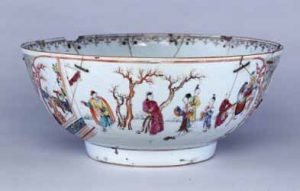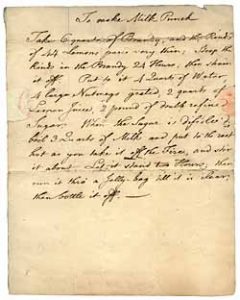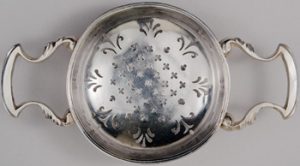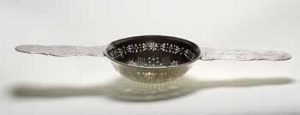By Rakashi Chand, Senior Library Assistant
This holiday season is unlike any other we have experienced in our lifetime. We cannot gather, there are no office parties, and some of us cannot risk seeing our families during the pandemic. So why not use the opportunity to take inspiration from the past and celebrate historically?
Have a cup of punch!
Punch was the thing to do in 1773. On the evening of 16 December 1773, guests gathered at the home of Benjamin Edes. While they waited for darkness to fall, the family punch bowl was filled multiple times. Benjamin’s son Peter later wrote in a letter to his grandson:
“I recollect perfectly well that in the afternoon preceding the evening of the destruction of the Tea a number of gentlemen met in the parlour of my father’s house how many I cannot say as…I was not admitted to their presence. my station was in another room to make punch for them in the bowl which is now in your possession and which I filled several times– they remained in the house till dark…”

Benjamin Edes and his guests made their way to his office on Queen Street to disguise themselves as Indians before joining others on Griffin’s Wharf, where the three ships carrying tea were docked. Young Peter followed the group and related the action to his grandson:
“The Indians worked smartly, some were in the hold immediately after the hatches were broken open, fixing the ropes to the tea chests, others were hauling up the chests, and others stood ready with their hatchets to cut off the binding of the chests, and others cast them overboard.”
Strangely well-orchestrated, in three hours they had disposed of three hundred and forty-two chests containing over 92,000 pounds of tea. John Adams, wrote about it admiringly in his diary entry for 17 December:
“This is the most magnificent Movement of all. There is a Dignity, a Majesty, a Sublimity, in this last Effort of the Patriots, that I greatly admire.”
Now you must be wondering what was in that punch that could launch three hundred chests in to the sea? Sadly, we don’t have that recipe.
But, we do have another infamous punch recipe: Benjamin Franklin’s Milk Punch! Let me introduce you to the strange world of milk punch, popular in 18nth century festivities. While Franklin is famous for his many inventions, such a cosmopolitan man could certainly invent an amazing drink as well. Luckily, he enclosed a recipe for his milk punch in an 11 October 1763 letter to his dear friend James Bowdoin.

For the adventurous, the following is a modern interpretation of Franklin’s recipe, with portions reduced to one quarter of those suggested by Franklin. The flavor is lemony, with a slightly medicinal kick.
Ingredients:
6 cups (3 pints) of brandy
11 lemons
2 cups lemon juice
4 cups (1 quart) of spring water
1 freshly grated nutmeg
1 1/8 cups (1/2 lb) of sugar
3 cups of whole milk
Directions:
Zest eleven lemons.
Squeeze 2 cups of lemon juice.
Steep the lemon zest in the brandy for 24 hours.
Strain out the lemon zest.
Add 4 cups of spring water, 1 freshly grated nutmeg, 2 cups of lemon juice, and 1 1/8 cups of sugar to the brandy.
Stir until the sugar dissolves.
Bring 3 cups of whole milk to a boil.
As soon as the milk boils, add it hot to the brandy mix and stir.
The heat, lemon juice, and alcohol will begin to curdle the milk.
Let the punch stand for 2 hours.
Strain the punch through a jelly bag (or pillow case) until clear. Serve cold.
Naturally, Franklin and Edes were not the only ones imbibing in punch on late December nights. John Hancock certainly enjoyed a glass or two. Here is Hancock’s own punch strainer:


Join us for a cup of Holiday Punch by sharing your favorite recipes, or favorite punch stories in the comments below.

